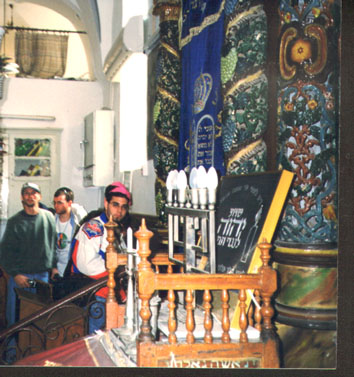The area was forested in the 16th century. This spot was the city limit. Here at the edge of the forest, facing the setting sun on Friday afternoon, white robed mystics would greet the Shabbath. They sang six psalms, corresponding to the six weekdays, describing the process of redemption, and a hymn composed in Safed by Rabbi Shlomo Alkabetz, L’cha Dodi. The poem, like the psalms (collectively known as the Kabbalat Shabbat service), describes the Shabbat as an integral part of redemption.
Belief in the imminent arrival of the messiah, central to the Jewish faith, is illustrated in the following episode (from Shivchey HaAri) featuring the most famous of the mystics, the “Ari,” Rabbi Yitzchak Luria. This young sage, whose teachings profoundly influenced the Chassidic movement two centuries later, died at age 38, three years after he arrived in Safed.
“Once while his disciples were singing L’cha Dodi, the Ari suddenly turned to them and announced, “My friends, let us go to Jerusalem right now, and greet the messiah!” Some agreed at once, but others hesitated, saying that Jerusalem was too distant to reach before the Shabbat. The Ari, shuddering with anguish, replied “If you had all believed with perfect faith, the messiah would have come immediately! Because you hesitated, the moment of favor is lost, and we are condemned to return to exile.”
A synagogue was built on the site where the Ari and his disciples sang the Kabbalat Shabbat service. Because the present congregation is comprised primarily of European Jews, it is called the Ari Ashkenazi.
The Entrance.
No mezuzah is affixed to the synagogue’s entrance. According to Jewish law, a mezuzah must be affixed on a room used for eating, sleeping, or conversing. A mezuzah is not required since these activities are not permitted in this synagogue. (There is a small room in the back with a mezuzah for Kiddush and Third Meal.)
The Bima.
The platform in the middle is for reading the Torah. There are two reasons for the platform: first, everyone can hear the Torah reading easily; and second, reading the Torah from the platform symbolizes receiving the Torah from the heights of Mount Sinai. When the Torah is read, it should be listened to attentively as if for the first time at Sinai. The Torah is read in the center of the synagogue, symbolizing its centrality in Jewish life.
There is a notch in the bima where it faces the door. During the War of Independence a bomb fell in the courtyard, and a piece of shrapnel flew into the synagogue. Because the explosion occurred during the Amida at the moment when the congregation was bowing, the shrapnel flew over the head of the worshipper near the door, imbedding itself in the bima.
The Ark.
The striking, intricate ark was hand-carved over one hundred years ago. A Torah crown faces the congregation over the ark. The Ari taught that by diligently studying the Torah and fulfilling its commandments, accompanied by good deeds of loving kindness, everyone and anyone can attain the crown of Torah.
Elijah’s Chair.
The room with the mezuzah in the back of the synagogue is used for meals. Inside is an Elijah’s Chair (used during the circumcision ceremony). Popular belief (and many contemporary people) testifies that if a childless couple sits in the chair they will be blessed with a baby boy within a year. (It works even if you already have children.)
Buy books about Safed and the ancient masters of Kabbalah at the Kabbala Online Shop.
Adapted from: Safed: Six Self-Guided Tours, by Yisrael Shalem of blessed memory.
This book is available from Ascent, Box 296, Safed, Israel; email: ascent@AscentOfSafed.com

